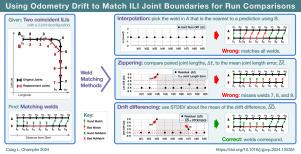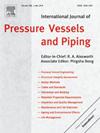使用里程计漂移匹配ILI联合边界进行运行比较
IF 3
2区 工程技术
Q2 ENGINEERING, MECHANICAL
International Journal of Pressure Vessels and Piping
Pub Date : 2024-11-19
DOI:10.1016/j.ijpvp.2024.105351
引用次数: 0
摘要
重复重合管道检测用于计算缺陷到缺陷的腐蚀增长速率(cgr),以获得准确的复检间隔。首先,一对检查在管道接头之间的边界对齐。然后使用模式匹配来匹配成对接头上的单个缺陷。节理边界匹配是一个对应问题,可以用“漂移”来描述,即对应节理边界处测程值的差异。在这里,漂移是形式化和特征化的。描述了目前常用的关节边界匹配方法——插值法、拉链法和直接里程法。我们使用漂移公式来说明为什么现有的方法会产生错误的匹配(1)在存在不良记录的路线时,(2)在清管器速度变化的里程计中存在非线性时,以及(3)其他检查问题。我们开发了一种新的基于证据的漂移直觉,作为位置估计状态机在检查猪时的系统偏差。接下来是使用漂移的一阶差分来推导位置特定的漂移差分距离度量。我们认为这个值是趋势平稳的。结果部分比较了四种指标识别常见关节边界匹配挑战的能力。我们发现直接匹配和插值是不可靠的。这些方法产生难以检测的错误,因为它们依赖于最近邻匹配标准。拉链和漂移差工作得更好。它们都依赖于管道重组附近的幼崽。当没有幼崽或重组规模很大时,它们都失败了。由于拉链使用朴素的模式匹配,当不对应的接头处于类似位置时,容易出现混叠错误。相反,漂移差分是特定于位置的,不受这种错误的影响。最后,我们证明了推导背后的假设对于示例数据集是有效的。本文章由计算机程序翻译,如有差异,请以英文原文为准。

Using odometry drift to match ILI joint boundaries for run comparisons
Repeat coincident inline pipeline inspections are used to calculate defect-to-defect corrosion growth rates (CGRs) for accurate reinspection intervals. First, a pair of inspections is aligned at the boundaries between pipe joints. Pattern matching is then used to match individual defects on paired joints. Joint-boundary matching is a correspondence problem that can be described in terms of “drift”, which is the difference in odometry values at corresponding joint boundaries. Here, drift is formalized and characterized. It is used to describe current joint-boundary matching methods — interpolation, zippering, and direct odometry comparison. We use the drift formulation to illustrate why existing methods produce false matches (1) in the presence of poorly documented reroutes, (2) when there are nonlinearities in the odometry from pig speed changes, and (3) from other inspection problems. We develop a new evidence-based intuition for drift as the systematic bias of position-estimating state machines on inspecting pigs. This is followed by deriving a position-specific drift differencing distance metric using the first-order differencing of the drift. We show this value to be trend stationary. The results section compares the four metrics’ abilities to identify common joint-boundary matching challenges. We found that direct matching and interpolation are unreliable. These methods generate difficult-to-detect mistakes because they rely on a nearest-neighbor matching criterion. Zippering and drift differencing work much better. Both rely on pups in the vicinity of pipeline reconfigurations. They both fail when there are no pups or when a reconfiguration is large. Because zippering uses naive pattern-matching, it is subject to aliasing mistakes when non-corresponding joints are in analogous positions. In contrast, drift differencing, which is position-specific, is immune to this type of error. Finally, we show that the assumptions behind the derivation are valid for an example dataset.
求助全文
通过发布文献求助,成功后即可免费获取论文全文。
去求助
来源期刊
CiteScore
5.30
自引率
13.30%
发文量
208
审稿时长
17 months
期刊介绍:
Pressure vessel engineering technology is of importance in many branches of industry. This journal publishes the latest research results and related information on all its associated aspects, with particular emphasis on the structural integrity assessment, maintenance and life extension of pressurised process engineering plants.
The anticipated coverage of the International Journal of Pressure Vessels and Piping ranges from simple mass-produced pressure vessels to large custom-built vessels and tanks. Pressure vessels technology is a developing field, and contributions on the following topics will therefore be welcome:
• Pressure vessel engineering
• Structural integrity assessment
• Design methods
• Codes and standards
• Fabrication and welding
• Materials properties requirements
• Inspection and quality management
• Maintenance and life extension
• Ageing and environmental effects
• Life management
Of particular importance are papers covering aspects of significant practical application which could lead to major improvements in economy, reliability and useful life. While most accepted papers represent the results of original applied research, critical reviews of topical interest by world-leading experts will also appear from time to time.
International Journal of Pressure Vessels and Piping is indispensable reading for engineering professionals involved in the energy, petrochemicals, process plant, transport, aerospace and related industries; for manufacturers of pressure vessels and ancillary equipment; and for academics pursuing research in these areas.

 求助内容:
求助内容: 应助结果提醒方式:
应助结果提醒方式:


